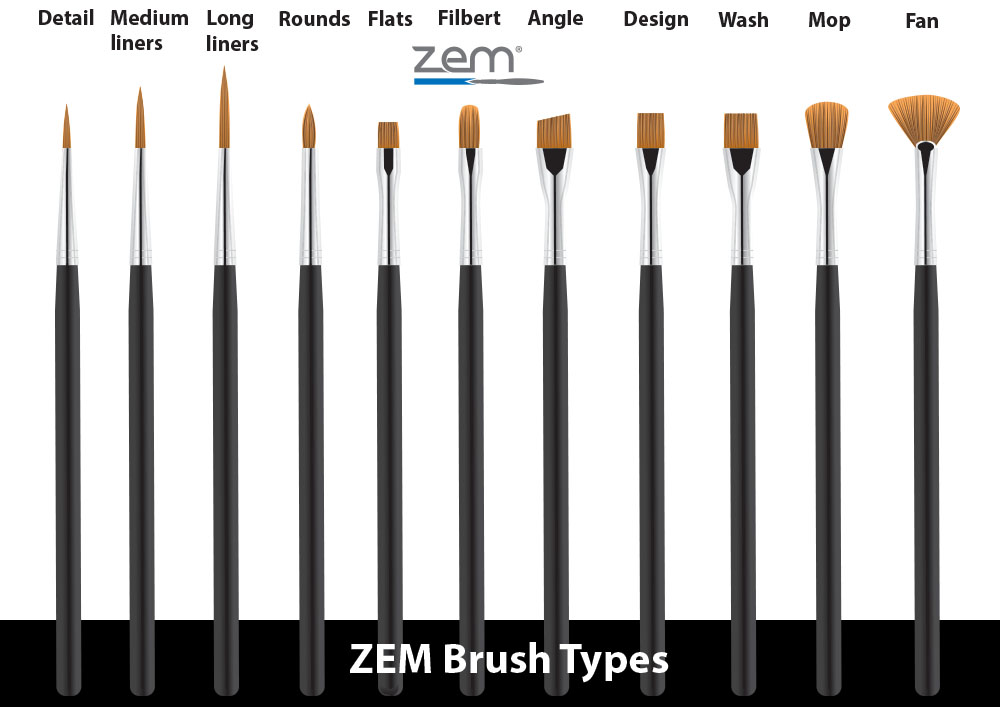
A perfect paintbrush is essential for artists to help bring their creativity to life. Whether you are using Acrylic, oil, or watercolor paints, an appropriate paintbrush is vital to execute your artistic vision with ease.
But with plenty of artists’ paintbrushes on the market, it would be daunting to understand where to start. A lot of choices have to be made, from various sizes and shapes to natural or synthetic bristles. However, knowing the different types and usages of artist brushes will aid in making your selection.
To help you choose the perfect artist paintbrush, we list down some common artist paint brushes and their uses.
Different Types of Artist Paintbrushes
The paintbrushes come in different shapes, sizes and with different bristles, too. Each of these is used for various purposes and provide details to your art in their unique ways. Choosing the paintbrush depends upon what kind of art you’d like to produce, the type of strokes, and the painting techniques.
Some paintbrushes work better with more fluid pigments (softer), and others are better with heavy pigments (firmer). Some paintbrushes will help create fine lines and other kinds that provide texture. Some paintbrushes are best for highlighting. We recommend testing various brushes until you get your perfect match.
To understand what works best for you, take a look at some of the typical artist brushes.
Round Brushes: Round paintbrushes are the most adaptable kind as they are used in several ways. A round brush comes with a close bristle gathering and a round or pointed tip. They are versatile and ideal for adding fine details, drawing and filling in smaller areas, applying washes and linework. Round paintbrushes work better with thinner paints.
Look for the top-quality round brush that has a good spring in the bristles and snap straight while drawing away from the surface.
Flat Brushes: With a flat tip and long or medium bristles, flat brushes make fine thin lines or thick, consistent strokes. They are versatile and best for sketching everything from filling in large spaces to creating impasto, bold strokes, or washes. The flat brushes will allow you to maneuver them more easily.
Fan Brushes: Fan Brushes are in the shape of an open fan and are used mainly to blend and make marks seem like foliage in landscapes. Their splayed bristles help create intriguing textural effects on clouds, trees, and other natural elements, mix colors, and smooth brush strokes. While the fan brushes with natural bristles are efficient in smoothing, blending, and feathering, synthetic bristles are best for texture. They can also be used for adding subtle highlights to darker areas or blending backgrounds.
Filbert Brushes: These are flat brushes with the hair rounded into an oval at the tip. They are the most versatile among brush shapes and a staple of acrylic and oil painting. With domed edges, the Filbert Brushes have either medium or long bristles. They work well for detail and coverage.
Angular Brushes: Angular or angle brushes are useful for making clean lines. They are flat with an angled edge and are perfect for drawing curved lines and filling in smaller areas or corners where the tip is easily reachable. The angular paintbrushes are another versatile tool that comes in handy for painting larger areas.
Mop Brushes: Mop brushes have soft bristles with a rounded edge, and they come in larger sizes. They go well with watercolors and are great at creating washes of colors. For those who do layered sketching, mop brushes are useful to apply a thin glaze of color over the drying layers.
Liner or Rigger Brushes: Liner brushes, also known as rigger brushes, are thin paintbrushes with long bristles. The tips of the brushes are either flat or square and small, which helps in writing out numbers and letters. Liner brushes are best when it comes to covering small areas and fine details. The long liner brushes and medium liner brushes are best for creating perfectly fine thin lines.
Wash Brushes: Wash brushes are wide, flat paintbrushes useful to hold a lot of water and pigment. They are perfect for varnishing providing the maximum coverage quickly and smoothly. Wash brushes are thicker than other brushes and helpful to create nice bold strokes. The edge of the wash brushes can be used to drawfine lines, stripes, and straight edges.Acrylic wash brushes are the largest of others, with a square end and medium to long hairs.
Deerfoot Brushes: These are round-shaped brushes that appear to have been cut in half at a slant and are useful for stippling to give a better texture and foliage effect. The Deerfoot Brushes have stippled marks to create a textural look.
Besides these common artist brushes, there are also other kinds of paintbrushes used to paint, like Cat's Tongue Brushes, Stencil Brushes, Bright Brushes, etc.
The art of painting is magic, where you will be able to explore the world by producing creative art pieces from your imagination. Paintbrushes are the magic wands that help unleash your creativity, and the right paintbrush is important to bring alive your innovative thoughts in the form of art.
You can experiment with the different ways that the artist brushes can make by using the edges, applying pressure in different ways, and varying the amount of paint. This knowledge will help you unlock your hidden creative genius as an artist.
If you are a budding artist or an expert looking for artist brushes, explore top-quality artist brushes at Zem Brush. We offer various artist paintbrushes at reasonable prices. Pick the paintbrush that suits your painting needs and explore your creativity now!
Other Articles you must read:
Why I Love the Underrated Cat’s Tongue Brush
Brush Care 101: How to Clean your Paintbrushes
How to Use Three Watercolor Washes in One Illustration - Video
Fired Arts - Brush Stroke Mums
Questions and Answers about enjoying Watercolor Painting with Artist Erika Barriga

